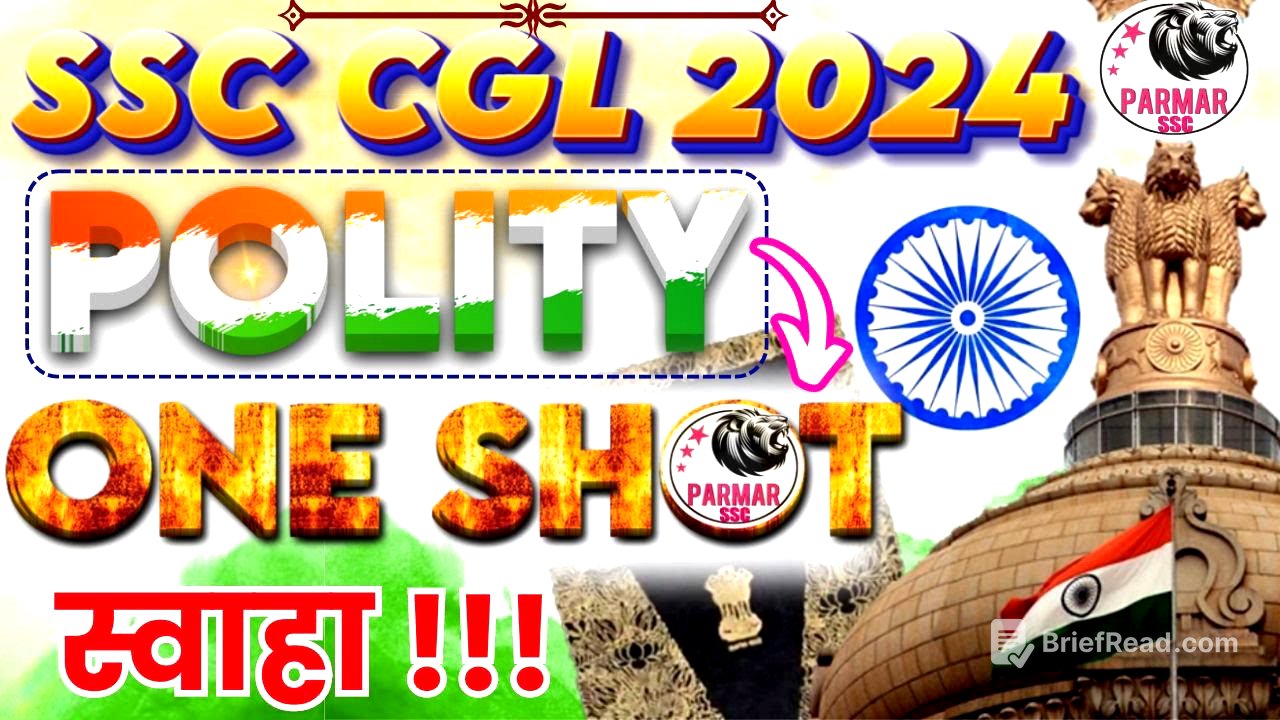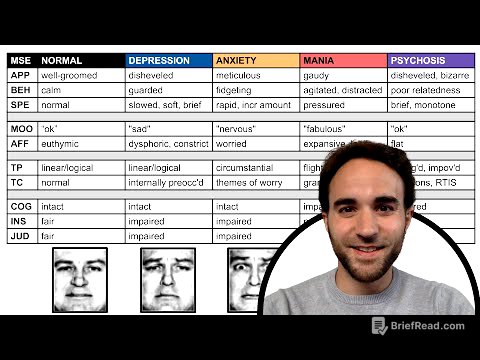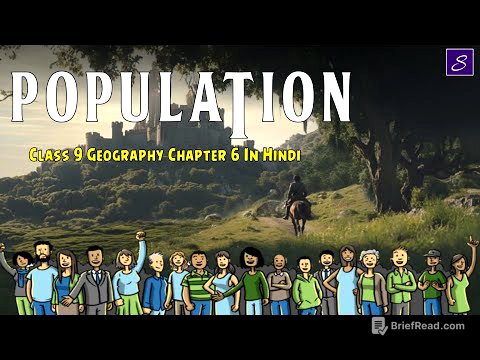TLDR;
This video provides a comprehensive overview of Indian Polity, focusing on the structure and functions of the Indian government as defined in the Constitution. It covers key aspects such as the roles and powers of the President, Vice President, Prime Minister, and the Parliament. Additionally, it explains the judiciary system, including the Supreme Court and High Courts, and touches on important topics like fundamental rights, directive principles, and emergency provisions.
- Overview of the Indian Constitution, focusing on key articles and schedules.
- Explanation of the roles and powers of the President, Vice President, and Prime Minister.
- Detailed discussion on the structure and functions of the Parliament and the judiciary.
- Insight into fundamental rights, directive principles, and emergency provisions.
Introduction [1:04]
The lecture begins with a welcome and an assurance of good audio quality. The instructor outlines the plan to cover Indian politics, starting with Part Five of the Constitution, which includes articles from number 52 to 151. This part is divided into five chapters, focusing on the executive, parliament, ordinance power, the Supreme Court, and the Comptroller and Auditor General (CAG).
Part Five: Chapters and Key Articles [3:36]
Part Five of the Constitution is divided into five chapters: the Executive (Articles 52-78), Parliament (Articles 79-122), Ordinance Power (Article 123), the Supreme Court (Articles 124-147), and the CAG (Articles 148-151). The instructor emphasizes the importance of these sections for various competitive exams, noting that Part Six is also significant but will require less time to understand once Part Five is clear.
Union Executive: President, Vice President, and More [7:59]
The Union Executive includes the President, Vice President, Prime Minister, Council of Ministers, and Attorney General. The lecture will start with the President. The instructor notes the order of past presidents, highlighting Dr. Rajendra Prasad as the longest-serving and mentioning key facts about Zakir Hussain and Fakhruddin Ali Ahmed. The current President, Draupadi Murmu, is the 15th President of India.
President of India: Articles 52 to 62 [10:16]
Articles 52 to 62 of the Constitution detail the office of the President. Article 52 states there shall be a President of India. Article 53 describes the executive power of the Union, vested in the President, who is also the Supreme Commander of the defense forces. Article 54 discusses the election of the President, which is indirect, involving elected MPs and MLAs through proportional representation with a single transferable vote.
Presidential Elections, Term, and Qualifications [12:07]
The presidential election is indirect, using proportional representation with a single transferable vote. Elected MPs and MLAs participate. A candidate needs 50 electors as proposers and 50 as seconders. The term of office is five years (Article 56). Re-election is permitted any number of times (Article 57). Qualifications include being a citizen of India, being 35 years of age, and being qualified to be a member of the Lok Sabha (Article 58).
Conditions and Impeachment of the President [16:06]
The conditions for the President's office (Article 59) include not being a member of Parliament or any state legislature. The President takes an oath administered by the Chief Justice of India (Article 60). Impeachment (Article 61) is the process for removing the President, based on violation of the Constitution, though this term is not defined in the Constitution. The impeachment process can start in either the Lok Sabha or Rajya Sabha with a 1/4 member signature, followed by a 14-day notice to the President and passage by a special majority (2/3rd of the members present and voting).
Trick to Remember Articles 52-62 and Time of Election [20:11]
A trick to remember the articles is "Prem tracking pe challana hai" (P-President, R-Executive Power, E-Election, M-Manner, T-Term, Q-Qualification, O-Oath, C-Conditions, I-Impeachment). Article 62 discusses the time of holding elections to fill vacancies. The President gives his resignation to the Vice President. Elections must be held as soon as possible to fill any vacancy.
Vice President of India: Articles 63 to 71 [22:24]
The lecture transitions to the Vice President of India, with current VP Jagdeep Dhankar being the 14th. Articles 63 to 71 cover the Vice President. Article 63 establishes the office of the Vice President. Article 64 states the Vice President shall be the ex-officio Chairman of the Rajya Sabha. Article 65 specifies that the Vice President acts as President during vacancies or absence of the President. If both President and Vice President are absent, the Chief Justice of India acts as President.
Election and Impeachment of the Vice President [27:00]
Article 66 details the election of the Vice President by an electoral college consisting of all members of Parliament (both elected and nominated). The Vice President is elected through an indirect election. All MPs participate in the impeachment, unlike the President's impeachment where MLAs do not participate. Article 67 specifies a five-year term. The President administers the oath. Article 71 addresses disputes related to the election of the President and Vice President, which are resolved by the Supreme Court.
Pardoning Power of the President and Executive Power of the Union [29:37]
Article 72 discusses the President's power to grant pardons, reprieves, respites, or remissions of punishment. This includes the power to suspend, remit, or commute sentences in certain cases. There are five types of pardons: pardon, commute, remission, respite, and reprieve. Article 73 defines the extent of the executive power of the Union.
PM and Council of Ministers: Articles 74 to 78 [31:35]
The lecture moves to the Prime Minister and Council of Ministers (Articles 74-78). Article 74 states there shall be a Council of Ministers headed by the Prime Minister to aid and advise the President. The Prime Minister is the Head of Government, while the President is the Head of the Country. The advice is binding on the second instance. Article 75 covers other provisions as to ministers, including appointment by the President, holding office during the President's pleasure, collective responsibility to the Lok Sabha, and oath administration by the President.
Attorney General and Conduct of Government Business [36:34]
Article 76 discusses the Attorney General, the highest law officer of the country, appointed by the President. The Attorney General's duties include advising the government on legal matters and representing the Government of India in all courts. The Attorney General holds office during the pleasure of the President. Article 77 states that all business of the Government of India is conducted in the name of the President.
Duties of the PM and End of Chapter One [40:30]
Article 78 outlines the duties of the Prime Minister, including communicating all decisions of the Council of Ministers to the President. The Prime Minister acts as a linkage between the President and the Council of Ministers. It also mentions that the maximum number of Council of Ministers cannot exceed 15% of the Lower House.
Parliament of India: Composition and Key Articles [42:31]
The lecture transitions to the Parliament of India (Articles 79-122). Article 79 discusses the composition of Parliament, which includes the Lok Sabha, Rajya Sabha, and the President. The President is an integral part of Parliament because no bill can become an act without presidential assent. India follows a parliamentary form of government, adopted from Britain, also known as the Westminster Model.
Rajya Sabha: Composition and Key Details [45:12]
Article 80 discusses the Rajya Sabha, also known as the Council of States. Members are indirectly elected by MLAs through proportional representation with a single transferable vote. The Rajya Sabha is a permanent house, with members serving six-year terms, and one-third of the members retiring every two years. The first sitting was on May 13, 1952. The maximum strength can be 250 members, with 238 elected and 12 nominated by the President from the fields of literature, science, art, and social service.
Lok Sabha: Composition and Election System [48:11]
Article 81 discusses the Lok Sabha, also known as the House of People. Members are directly elected through the first-past-the-post system, taken from Britain. The first sitting was on April 17, 1952. The term is five years, unless dissolved earlier. The maximum strength can be 550 members, with 530 from the states and 20 from the Union Territories.
Delimitation Commission and Sessions of Parliament [52:54]
Article 82 discusses the Delimitation Commission, which divides the country into constituencies. The commission was formed in 1952, 1962, 1972, and 2002. The 84th Amendment has frozen delimitation until 2026, based on the 2001 census. Article 85 discusses the sessions of Parliament, which include the budget session (February to May), monsoon session (July to September), and winter session (November to December). The President summons and prorogues the sessions.
Adjournment, Special Addresses, and Rights of Ministers [57:19]
Adjournment is done by the Presiding Officer, while prorogation is done by the President. Article 87 discusses special addresses by the President, given after general elections and at the first session of every financial year. Article 88 covers the rights of ministers and the Attorney General, allowing them to speak in either house but vote only in the house they are members of.
Presiding Officers of Rajya Sabha and Lok Sabha [1:01:40]
Article 89 discusses the presiding officers of the Rajya Sabha, including the Chairman (Vice President) and Deputy Chairman. The Deputy Chairman is elected by the House. The Chairman gives resignation to the Vice President, and removal is done by the House with an effective majority. Article 93 discusses the Speaker and Deputy Speaker of the Lok Sabha, who are elected by the House.
Speaker and Deputy Speaker: Powers and Procedures [1:09:12]
Article 95 covers the power of the Deputy Speaker to perform the duties of the Speaker. If there is no Speaker, the Deputy Speaker performs the duties. If both are absent, a Panel of Chairpersons is used. If there is a vacancy, the President appoints a senior member. The Speaker gives resignation to the Deputy Speaker, and vice versa. Removal is done by the Lok Sabha with an effective majority.
Voting, Quorum, and Vacancy of Seats in Parliament [1:12:59]
Article 100 discusses voting in the House, with the Presiding Officer having a casting vote in case of a tie. It also covers quorum, which is 1/10th of the total members. Article 101 discusses the vacancy of seats, such as when an MLA becomes an MP.
Disqualifications, Penalties, and Powers of Parliament [1:16:31]
Article 102 discusses disqualifications for membership, including not being a citizen of India, holding an office of profit, or being of unsound mind. Article 105 covers the powers and privileges of Parliament, including freedom of speech.
Legislative Procedures: Ordinary Bills and Joint Sittings [1:18:45]
Article 107 discusses provisions for the introduction and passing of bills. Ordinary bills can be public (introduced by a minister) or private (introduced by a private member). Article 108 discusses joint sittings of both houses in case of a deadlock, called by the President and presided over by the Speaker of the Lok Sabha.
Money Bills: Definition and Procedures [1:22:46]
Article 109 and 110 define money bills. Money bills can only be introduced in the Lok Sabha. The Rajya Sabha has only recommendatory powers and 14 days to respond. Prior recommendation of the President is required. The Speaker of the Lok Sabha decides whether a bill is a money bill.
Assent to Bills and Types of Vetoes [1:26:15]
Article 111 discusses assent to bills, given by the President. The President has three types of vetoes: absolute veto, suspensive veto, and pocket veto. The suspensive veto is not available in the case of money bills.
Annual Financial Statement and Parliamentary Committees [1:32:07]
Article 112 discusses the annual financial statement, also known as the budget. The President presents it before both houses of Parliament. The Finance Minister presents the budget in the name of the President. The lecture also touches on the process of voting on demand for grants and the two types of expenditure: charged and made from.
Ordinance Power of the President and Question Hour [1:40:03]
Article 123 discusses the power of the President to promulgate ordinances during the recess of Parliament. The ordinance has the same force as an act of Parliament. The lecture also touches on Question Hour and Zero Hour in Parliament.
Censure Motion and No-Confidence Motion [1:43:55]
The lecture explains the difference between a censure motion and a no-confidence motion. A no-confidence motion can only be brought in the Lok Sabha and requires the government to resign if passed. A censure motion can be brought against a minister or the entire Council of Ministers, and it is not mandatory for the government to resign if passed.
Supreme Court: Establishment and Composition [1:51:35]
The lecture transitions to the Supreme Court (Articles 124-147). Article 124 discusses the establishment of the Supreme Court, consisting of a Chief Justice of India (CJI) and other judges. The current strength is CJI plus 33 other judges. The first sitting took place on January 28, 1950.
Appointment, Removal, and Qualifications of Supreme Court Judges [1:54:19]
The President appoints Supreme Court judges, who can resign to the President. Removal is based on proven misbehavior or incompetence, requiring a special majority in both houses of Parliament. Qualifications include being a judge of a High Court for five years or an advocate in the High Court for ten years, or being a distinguished jurist in the eyes of the President.
Acting CJI, Ad Hoc Judges, and Court of Record [2:01:43]
Article 126 discusses the appointment of an Acting Chief Justice of India by the President. Article 127 discusses the appointment of ad hoc judges to meet the quorum. Article 129 states that the Supreme Court is a court of record, with the power to punish for contempt of court.
Seat of the Supreme Court and Original Jurisdiction [2:05:24]
Article 130 declares Delhi as the seat of the Supreme Court, though the CJI can declare other places with the President's approval. Article 131 discusses the original jurisdiction of the Supreme Court, which includes disputes between the Center and states or between states.
Appellate Jurisdiction and Special Leave to Appeal [2:07:12]
Article 132 discusses the appellate jurisdiction of the Supreme Court. Article 136 discusses special leave to appeal by the Supreme Court.
Review of Judgments and Auxiliary Powers of the Supreme Court [2:09:03]
Article 137 discusses the review of judgments and orders by the Supreme Court, also known as judicial review. Article 140 discusses the auxiliary powers of the Supreme Court, which can be given by the Parliament.
Law Declared by the Supreme Court and Advisory Jurisdiction [2:11:21]
Article 141 states that the law declared by the Supreme Court is binding on all courts. Article 142 empowers the Supreme Court to pass any decree necessary for doing complete justice. Article 143 discusses the advisory jurisdiction of the Supreme Court, where the President can seek advice on matters of public importance.
Civil and Judicial Authorities and Trick to Remember Articles [2:14:17]
Article 144 states that all civil and judicial authorities must act in aid of the Supreme Court. A trick to remember the articles is "Supreme Court has offered a seat to SAARC countries" (S-Supreme Court, A-Acting CJI, A-Adhoc Judges, R-Retired Judges, C-Contempt of Court, S-Seat, O-Original Jurisdiction, A-Appellate Jurisdiction, R-Review).
CAG: Appointment and Duties [2:18:25]
The lecture transitions to the Comptroller and Auditor General (CAG) (Articles 148-151). Article 148 states there shall be a CAG, appointed by the President. Article 149 outlines the duties and powers of the CAG. Article 151 states that the CAG submits reports to the President, who tables them in Parliament. The CAG is known as the Guardian of Public Purse. The current CAG is Girish Chandra Murmu.
Part Six: State Government and Comparison with Union Government [2:21:14]
The lecture moves to Part Six, which discusses the state government. The structure mirrors the Union government, with a Governor (instead of President), CM plus Council of Ministers (instead of PM plus Council of Ministers), and Advocate General (instead of Attorney General).
State Legislature and Legislative Council [2:23:27]
Article 168 discusses the Constitution of the State Legislature. Some states have a bicameral legislature, with a Legislative Assembly and a Legislative Council. Only six states in India have a Legislative Council. The Parliament can create and abolish the Legislative Council with a simple majority.
Legislative Council: Composition and Key Details [2:28:29]
Article 169 discusses the abolition or creation of Legislative Councils. Article 171 details the composition of the Legislative Council, with members indirectly elected from various sources. The maximum strength of the Legislative Council is 1/3rd of the Legislative Assembly, with a minimum of 40.
Officers of State Legislature and Veto Power of Governor [2:34:25]
The lecture notes that the officers of the State Legislature are given before the officers of the Legislative Council. Article 200 discusses the veto power of the Governor, who can give consent, refuse to give consent, or reserve the bill for the President.
Governor: Appointment, Qualifications, and Pardoning Power [2:38:03]
Article 153 states there shall be a Governor in each state. Article 154 discusses the executive power of the state, vested in the Governor. The Governor is appointed by the President and serves during the President's pleasure. Qualifications include being a citizen of India and being 35 years of age. The Governor's pardoning power (Article 161) does not extend to death sentences or cases under martial law.
Council of Ministers and Advocate General [2:42:15]
Article 163 states there shall be a Council of Ministers headed by the Chief Minister to aid and advise the Governor. The Governor is the titular head, while the Chief Minister is the de facto head.
High Courts: Establishment and Key Details [2:43:34]
The lecture transitions to the High Courts (Articles 214-231). Article 214 states there shall be a High Court in each state. A High Court can serve as a common High Court for two or more states.
Appointment and Qualifications of High Court Judges [2:49:06]
The President appoints High Court judges, and the Governor administers the oath. Qualifications include being an advocate in the High Court for 10 years or holding a judicial office. There is no minimum age, but the maximum age is 62 years.
Judicial Review and Collegium System [2:50:43]
The lecture touches on the collegium system for the appointment of judges, which has been subject to judicial review. The collegium consists of the CJI and other judges.
Making of the Constitution: Key Figures and Committees
The lecture transitions to the making of the Constitution. The demand for a Constituent Assembly was first put forward by MN Roy. The Constituent Assembly was formed under the Cabinet Mission Plan. The first session was held on December 9, 1946, with Sachchidanand Sinha as the temporary chairman. Dr. Rajendra Prasad was elected as the permanent chairman.
Objective Resolution and Key Committees
On December 13, 1946, Nehru presented the objective resolution. The work was divided into eight major committees and several minor committees. The drafting committee, chaired by Ambedkar, was the most important.
Key Facts and Adoption of the Constitution
The Constitution took 2 years, 11 months, and 18 days to make, with 11 sessions. Prem Bihari Narayan Raizada wrote it in English, and Vasant Kumar Vaidya wrote it in Hindi. Nandlal Bose decorated it. The elephant was the symbol of the Constituent Assembly. The Constitution was adopted on November 26, 1949, and implemented on January 26, 1950.
Functions of the Constituent Assembly and Vacancy of Seats
The Constituent Assembly also adopted the National Flag and Anthem.
Features of the Constitution: Length and Federalism
The first feature of the Constitution is that it is the longest written constitution. It is a federation with a strong center, taken from Canada.
Key Borrowings from Different Countries
The structural part is from the Government of India Act 1935. The political part is from Britain. The philosophical part is from the USA. DPSP is from the Constitution of Ireland.
Schedules of the Constitution
The Constitution originally had 395 articles, 22 parts, and eight schedules. Today, there are 25 parts and 12 schedules. The schedules are remembered with the acronym "Tears of Old PM."
Details of the Schedules
The schedules include: T-Territories, E-Emoluments, A-Affirmation, R-Rajya Sabha, S-Scheduled Areas, F-Federal Provisions, O-Official Languages, L-Land Provisions, D-Defection, P-Panchayat, M-Municipality.
Delimitation Commission and Sessions of Parliament
Article 82 discusses the Delimitation Commission, which divides the country into constituencies. The commission was formed in 1952, 1962, 1972, and 2002. The 84th Amendment has frozen delimitation until 2026, based on the 2001 census. Article 85 discusses the sessions of Parliament, which include the budget session (February to May), monsoon session (July to September), and winter session (November to December). The President summons and prorogues the sessions.
Adjournment, Special Addresses, and Rights of Ministers
Adjournment is done by the Presiding Officer, while prorogation is done by the President. Article 87 discusses special addresses by the President, given after general elections and at the first session of every financial year. Article 88 covers the rights of ministers and the Attorney General, allowing them to speak in either house but vote only in the house they are members of.
Presiding Officers of Rajya Sabha and Lok Sabha
Article 89 discusses the presiding officers of the Rajya Sabha, including the Chairman (Vice President) and Deputy Chairman. The Deputy Chairman is elected by the House. The Chairman gives resignation to the Vice President, and removal is done by the House with an effective majority. Article 93 discusses the Speaker and Deputy Speaker of the Lok Sabha, who are elected by the House.
Speaker and Deputy Speaker: Powers and Procedures
Article 95 covers the power of the Deputy Speaker to perform the duties of the Speaker. If there is no Speaker, the Deputy Speaker performs the duties. If both are absent, a Panel of Chairpersons is used. If there is a vacancy, the President appoints a senior member. The Speaker gives resignation to the Deputy Speaker, and vice versa. Removal is done by the Lok Sabha with an effective majority.
Voting, Quorum, and Vacancy of Seats in Parliament
Article 100 discusses voting in the House, with the Presiding Officer having a casting vote in case of a tie. It also covers quorum, which is 1/10th of the total members. Article 101 discusses the vacancy of seats, such as when an MLA becomes an MP.
Disqualifications, Penalties, and Powers of Parliament
Article 102 discusses disqualifications for membership, including not being a citizen of India, holding an office of profit, or being of unsound mind. Article 105 covers the powers and privileges of Parliament, including freedom of speech.
Legislative Procedures: Ordinary Bills and Joint Sittings
Article 107 discusses provisions for the introduction and passing of bills. Ordinary bills can be public (introduced by a minister) or private (introduced by a private member). Article 108 discusses joint sittings of both houses in case of a deadlock, called by the President and presided over by the Speaker of the Lok Sabha.
Money Bills: Definition and Procedures
Article 109 and 110 define money bills. Money bills can only be introduced in the Lok Sabha. The Rajya Sabha has only recommendatory powers and 14 days to respond. Prior recommendation of the President is required. The Speaker of the Lok Sabha decides whether a bill is a money bill.
Assent to Bills and Types of Vetoes
Article 111 discusses assent to bills, given by the President. The President has three types of vetoes: absolute veto, suspensive veto, and pocket veto. The suspensive veto is not available in the case of money bills.
Annual Financial Statement and Parliamentary Committees
Article 112 discusses the annual financial statement, also known as the budget. The President presents it before both houses of Parliament. The Finance Minister presents the budget in the name of the President. The lecture also touches on the process of voting on demand for grants and the two types of expenditure: charged and made from.
Ordinance Power of the President and Question Hour
Article 123 discusses the power of the President to promulgate ordinances during the recess of Parliament. The ordinance has the same force as an act of Parliament. The lecture also touches on Question Hour and Zero Hour in Parliament.
Censure Motion and No-Confidence Motion
The lecture explains the difference between a censure motion and a no-confidence motion. A no-confidence motion can only be brought in the Lok Sabha and requires the government to resign if passed. A censure motion can be brought against a minister or the entire Council of Ministers, and it is not mandatory for the government to resign if passed.
Supreme Court: Establishment and Composition
The lecture transitions to the Supreme Court (Articles 124-147). Article 124 discusses the establishment of the Supreme Court, consisting of a Chief Justice of India (CJI) and other judges. The current strength is CJI plus 33 other judges. The first sitting took place on January 28, 1950.
Appointment, Removal, and Qualifications of Supreme Court Judges
The President appoints Supreme Court judges, who can resign to the President. Removal is based on proven misbehavior or incompetence, requiring a special majority in both houses of Parliament. Qualifications include being a judge of a High Court for five years or an advocate in the High Court for ten years, or being a distinguished jurist in the eyes of the President.
Acting CJI, Ad Hoc Judges, and Court of Record
Article 126 discusses the appointment of an Acting Chief Justice of India by the President. Article 127 discusses the appointment of ad hoc judges to meet the quorum. Article 129 states that the Supreme Court is a court of record, with the power to punish for contempt of court.
Seat of the Supreme Court and Original Jurisdiction
Article 130 declares Delhi as the seat of the Supreme Court, though the CJI can declare other places with the President's approval. Article 131 discusses the original jurisdiction of the Supreme Court, which includes disputes between the Center and states or between states.
Appellate Jurisdiction and Special Leave to Appeal
Article 132 discusses the appellate jurisdiction of the Supreme Court. Article 136 discusses special leave to appeal by the Supreme Court.
Review of Judgments and Auxiliary Powers of the Supreme Court
Article 137 discusses the review of judgments and orders by the Supreme Court, also known as judicial review. Article 140 discusses the auxiliary powers of the Supreme Court, which can be given by the Parliament.
Law Declared by the Supreme Court and Advisory Jurisdiction
Article 141 states that the law declared by the Supreme Court is binding on all courts. Article 142 empowers the Supreme Court to pass any decree necessary for doing complete justice. Article 143 discusses the advisory jurisdiction of the Supreme Court, where the President can seek advice on matters of public importance.
Civil and Judicial Authorities and Trick to Remember Articles
Article 144 states that all civil and judicial authorities must act in aid of the Supreme Court. A trick to remember the articles is "Supreme Court has offered a seat to SAARC countries" (S-Supreme Court, A-Acting CJ









